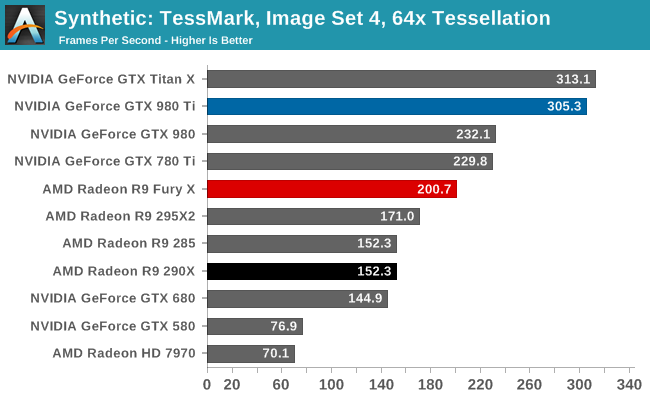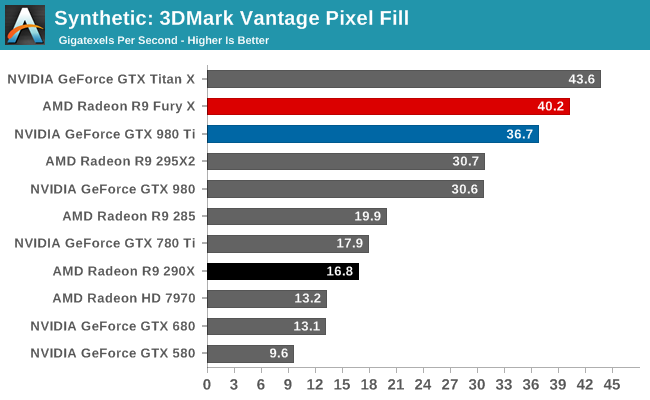The AMD Radeon R9 Fury X Review: Aiming For the Top
by Ryan Smith on July 2, 2015 11:15 AM ESTSynthetics
As always we’ll also take a quick look at synthetic performance. Since Fiji is based on the same GCN 1.2 architecture as Tonga (R9 285), we are not expecting too much new here.

First off we have tessellation performance. As we discussed in greater detail in our look at Fiji’s architecture, AMD has made some tessellation/geometry optimizations in GCN 1.2, and then went above and beyond that for Fiji. As a result tessellation performance on the R9 Fury X is even between than the R9 285 and the R9 290X, improving by about 33% in the case of TessMark. This is the best performing AMD product to date, besting even the R9 295X2. However AMD still won’t quite catch up to NVIDIA for the time being.

As for texture fillrates, the performance here is outstanding, though not unexpected. R9 Fury X has 256 texture units, the most of any single GPU card, and this increased texture fillrate is exactly in line with the theoretical predictions based on the increased number of texture units.

Finally, the 3DMark Vantage pixel fillrate test is not surprising, but it is none the less a solid and important outcome for AMD. Thanks to their delta frame buffer compression technology, they see the same kind of massive pixel fillrate improvements here as we saw on the R9 285 last year, and NVIDIA’s Maxwell 2 series. At this point R9 Fury X’s ROPs are pushing more than 40 billion pixels per second, a better than 2x improvement over the R9 290X despite the identical ROP count, and an important reminder of the potential impact of the combination of compression and HBM’s very high memory bandwidth. AMD’s ROPs are reaching efficiency levels simply not attainable before.










458 Comments
View All Comments
Ryan Smith - Friday, July 3, 2015 - link
Tessellation is where the GPU creates smaller triangles from a larger triangle.Digidi - Friday, July 3, 2015 - link
and where are the larger triangle come from?Digidi - Friday, July 3, 2015 - link
And the larger triangle come frome the cpu? So what i miss is a Benchmark mit small triangles from CPUDigidi - Friday, July 3, 2015 - link
Thank you. I have one more question. Where are the large triangle Comes from?I think they come from the cpu. what is when small triangles come from the cpu and not from the gpu. That Benchmark i'm missing
silverblue - Friday, July 3, 2015 - link
NVIDIA have a page on the subject (it's quite old, but the principle is the same):http://http.developer.nvidia.com/GPUGems2/gpugems2...
Ryan Smith - Friday, July 3, 2015 - link
One wouldn't send a bunch of small triangles from the CPU. It's inefficient.Digidi - Saturday, July 4, 2015 - link
Thank you for the Link silverblue and thank you for the answer Ryan. But why is it inefficient to get as much as possible polygons from the cpu?Is tessellation on the gpu so much better, than the transfer of the Polygons from cpu to gpu?
silverblue - Sunday, July 5, 2015 - link
Most modern GPUs are far better at generating geometry than even the best CPUs.Scali - Tuesday, July 7, 2015 - link
The CPU being a bottleneck with processing triangles is why nVidia introduced the first 'GPU' with the GeForce256: the geometry is uploaded only once to VRAM, and the GPU will perform T&L for each frame, to avoid the CPU bottleneck.Tessellation is the next step here: Very detailed geometry takes a lot of VRAM and a lot of bandwidth, causing a bottleneck trying to feed the rasterizers. So instead of storing all geometry in VRAM, you store a low-res mesh together with extra information (eg displacement maps) so the GPU can generate the geometry on-the-fly, to feed the backend more efficiently.
CrazyElf - Thursday, July 2, 2015 - link
Thanks for the review - that must have taken quite a bit to write.I hope you are feeling better now and back to normal.
As far as the GPU, yeah it's a disappointment that they were not able to beat the 980Ti. They needed 96 ROPs (I'd trade 3840 SP for that even for die), 8GB of VRAM (you might run out of VRAM before you run out of core), and probably 12 ACEs as well. Maybe 1/32 FP64 like on the GM200 would have helped too.
This thing needs to go down to $550 USD now. That and custom PCBs.